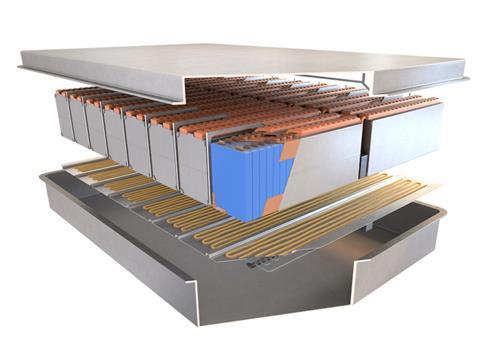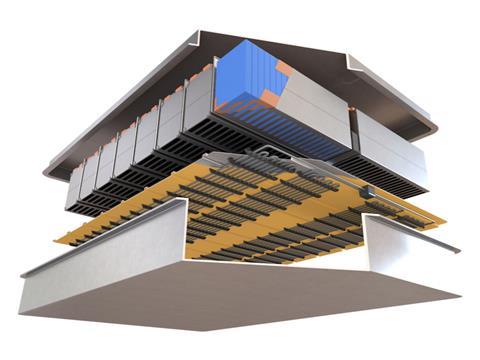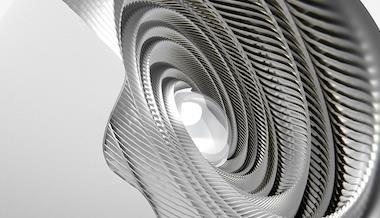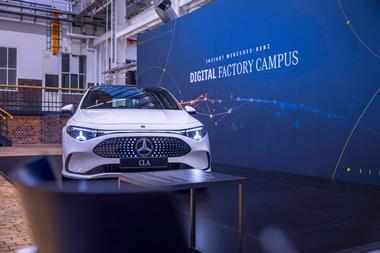What role can special coatings play in improving EV battery cell and pack assembly? AMS discussed the challenges with Calum Munro, PPG senior scientist, research and technology for automotive

Electric vehicle battery technology is well established, but as these vehicles reach the mass market and greater demands are made of the battery systems in terms of range and charging speed, challenges arise in respect of safety, performance and efficiency. Coatings specialists PPG have announced a raft of solutions that they claim will address a number of technical and environmental issues with existing battery pack technology and simplify areas of assembly. PPG senior scientist Calum Munro discussed some of the most pressing challenges facing OEMs and tier suppliers.
Munro outlined the company’s approach to battery cell and pack assembly: “We’re seeing a lot of different challenges across the industry, some things that were anticipated, and a few surprises emerging. We (PPG) have focused on eight main areas to help address the most critical issues. A couple are at the cell level, but the majority are at the pack assembly level.

Can new materials improve electrode performance?
The cell developments are aimed at improving the performance in electrodes and a cathode binder system, Munro explained: “We have developed an NMP free cathode binder system, which allows us to address some of the environmental health and safety concerns that are associated with the use of the traditional solvent of choice. In addition to addressing these concerns we’ve also been able to improve the overall performance of the electrode, and hence the performance of the battery”.
“Really these electrodes are just highly functional, very specialised coatings. They’re really highly pigmented coatings on a metal foil. So, it fits well with our expertise.”
Another material that PPG is working with is graphene. In recent years research and development has been progressing into the use of graphene in batteries and it has been reported that using the material in a battery’s electrodes can improve conductivity and performance while reducing the use of other materials, such as carbon. Munro noted that PPG is working on specific projects with customers but could not reveal any details: “We’re able to bring some graphene systems into play that really complement some of the newer emerging materials that are being utilised within the lithium-ion battery.”
“We recognise there are not two packs that are the same and no two sets of challenges that are the same. The requirements and the preferences are going to vary by OEM and by the design of the individual vehicle.”
Calum Munro, PPG
The battery pack structure also has to meet a number of challenging technical requirements and perhaps the most basic being resistance to corrosion and impact. It is now common with some of the newer skateboard designs for the pack to be integrated into the floor structure of the vehicle. Munro pointed out that: “very often with those designs the battery pack casing is exposed under the vehicle. So, you can appreciate that as currently metals are still a material of choice for the overall casing of those battery packs, traditional challenges like corrosion and impact come into play.”

EMI and RFI shielding are another consideration. “When you have a lot of electrical components in close proximity to each other, very often you can get crosstalk between these components, and that’s something that we’re seeing becoming more important with the new vehicle designs that are coming through. So, shielding becomes a real challenge,” explained Munro. He noted that ease of application of the shielding materials is something PPG had been working on, with the company offering spray-applied coatings. He added: “They can be applied to a broad range of substrates. They are very thin, so they do not require a material change or an overall design change if you find that you have a shielding problem late within the overall design cycle. Also, we can tune these shielding materials, so that they cover certain frequencies or they give a higher level of shielding”.
We’re now dealing with a very rapidly evolving field where, as an industry, we’re learning as we go on.
Within the battery assembly, there are a number of components that have to be joined to each other in some way and depending on the battery design; there are a range of different approaches. In some cases, mechanical fixtures are still utilised, but according to Munro, there is a trend towards bonding: “That could be bonding from cell to cell within a module and you can get up to 20 modules, depending on the design within the unit.
“There’s a lot of dissimilar materials that are utilised that could be bolted together as they aren’t necessarily conducive to welding. But using a structural adhesive means the process can be readily automated, allowing for scaling up of production as volumes increase.”
What are the big challenges in the assembly of EV batteries?
Munro highlighted three key areas that represented new and emerging challenges with the assembly of battery packs: Dielectric isolation, fire protection and thermal conductivity. “Looking at dielectric isolation, many of the current pack designs are operating in the 400 to 600-volt range, which is a high voltage system that requires the individual components to not only be separated from each other but also isolated from any human interaction.”.
“Also, the industry is looking to increase the voltages (up to and possibly beyond 1,000 volts) as this can offer a number of benefits to the way the battery operates, such as faster charging, improved management of the drivetrain and actually delivering a more cost-effective battery system. So electrical separation is something that’s critical and it’s something that we’re recognising is best done with a coating material”.
Incidents of electric vehicles catching fire, although few in number, have been widely reported and there are some unique challenges associated with fires and the battery pack system. Munro noted that there are some solutions already in place that help with two emerging scenarios around fire protection: “Initially the industry was making sure that the battery was protected from an external fire source. This has seen the use of more traditional standards that had been developed for ensuring good performance with a gasoline or a diesel tank within the vehicle.
“We’re able to bring some graphene systems into play that really complement some of the newer emerging materials that are being utilised within the lithium-ion battery”
Calum Munro, PPG
“But what’s really emerged as a challenge, and is very much still in flux in terms of some of the standards and approaches, is the fire that originates within the battery system. If the fault occurs within the battery, whether it’s due to some kind of projectile that punctures one of the cells or something that causes a short within the battery, you’ve got a lot of energy stored within these batteries, so as that energy is released by some fault or accident, the battery will start to heat up very rapidly, and that can induce thermal runaway.”
“This results in a cascade event from cell to cell where, as one heats up and then starts to fail catastrophically, it generates a lot more heat and internal fire. That then heats the surrounding cells and it pushes out”.
Munro observed that while it is not something that is anticipated to be a frequent occurrence there is definite need for internal fire protection solutions. “What you ideally want to do is minimise it to one or two cells, keep it within a module. But, ultimately, you’re really trying to make sure that there’s not a rupture of the pack itself, and there’s not a breach into the cabin of the vehicle”.
Compounding this challenge, the industry has been moving towards creating higher energy density systems, within as small volume as possible and the using new materials. “Looking ahead we will have more energy to deal with if something happens here, and that will change the nature of fire if it occurs,” explained Munro. “With some of the older, less energetic materials, they burn at a manageable temperature, so it was something that could be controlled with standard [prevention] materials,” he added.
Utilising some of these new active [battery] materials, could see a fire reaching temperatures of over 1,000°C. This has seen fire resistance testing of battery packs taken to a range of up to 2,000°C. “Dealing with those temperatures becomes quite important if we’re thinking about protecting the pack assembly from rupturing. If you have an aluminium structure, it will melt if the temperature reaches over 650°C, unless there is some protection there. That breaches the pack and it allows more oxygen in to fuel the fire. When you get up above 1,300 -1,400°C, you start to see the same effect on steel,” commented Munro. PPG is able to utilise their experience with coatings that have been designed to help protect metal structures from extremely high temperature fire situations. “We’re actively working with a range of OEMs and battery makers to provide one element in a system that will help to provide a higher level of fire protection,” stated Munro.
Maintaining battery performance
Lithium-ion batteries have a narrow, optimal thermal operating window, between 15-35°C, so thermal conductivity is another important consideration for the battery makers, and given vehicles can be operating in climates and seasons where temperatures could be anywhere from -40 to +55°C, it’s a considerable challenge to keep the battery pack functioning efficiently. Munro commented that “the thermal challenge is probably one of the biggest areas of concern.” While the latest lithium-ion batteries are very efficient, any slight drop in efficiency, even if it’s less than 1%, is going to translate into the generation of heat in use. Munro explained: “So, any time you’re charging quickly, you will see that, and also when discharging. Although typically you’re not discharging as quickly you’re still going to generate heat over continuous use”.
The majority of battery pack designs now use a thermal management system that features electronic components monitoring the temperature within the battery, and also some physical components that allow for heat exchange. In the case of the latter these often take the form of cooling plates or heat exchangers, and are brought into proximity to the cells. Munro pointed out that it is important to ensure that you’re transferring heat efficiently from the cells into those cooling systems, and that’s where some thermally conductive materials are being utilised by the industry. “The [automotive] industry has borrowed solutions from the electronics industry, and those have come over in the form of thermal pad solutions. These are pad-like materials, which have reasonable levels of thermal conductivity, and you sandwich it between the two items that you want to move heat between.
“But what you’re really trying to do here is fill microscopic air gaps. Air is a terrible thermal conductor. So, if you have any kind of air gap, even if it’s on a microscopic scale, then it negatively impacts how well you can move heat between the hot surfaces and the cold surfaces to be able to maintain that ideal situation”.
In the thermal management area, PPG offers their Coratherm thermal gap fillers, which are a liquid dispensed material that provides the functions of thermal conductivity, and can be applied using automated systems.
Dealing with rapidly developing technology
PPG is working closely with a number of cell manufacturers and OEMs and Munro offered some insight into how battery production was evolving across the industry: “We’re seeing a lot of different models in play across the industry, but I would say there’s a general evolution towards the OEMs taking more responsibility [for battery production], but their approach varies.”.
“With some of the solutions that I talked about at the cell level, we’re working very closely with the major cell manufacturers to bring those solutions to bear. But we’re also working very closely with the OEMs, because they are still going to want to understand and specify what’s happening within the cell they have ordered”.
“Also, the [automotive] industry has not, as yet, arrived at standardised design [for EV powertrains]. So, while there will be some commonalities where it makes sense, the automotive manufacturers will want to differentiate on drivetrain and drive performance, and I would be surprised if there’s ever a full consolidation of a design solution across the industry”.
“So, we recognise there are not two packs that are the same and no two sets of challenges that are the same. The requirements and the preferences are going to vary by OEM and by the design of the individual vehicle. We’re now dealing with a very rapidly evolving field where, as an industry, we’re learning as we go on”.






































No comments yet